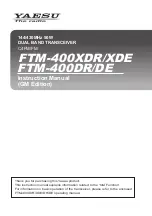
RF Technology R50
Page 21
7.4.21 Car r ier Oper ated Switch (COS) Output
The carrier operated switch output is via an Opto-coupler. Collector and
emitter connections are available to allow connection for source or sink.
The Opto-coupler can be linked inside the receiver to be on when a carrier is detected
or to be on in the absence of carrier.
Internal connections are provided by a relay so that 12VDC can be connected to the
600 Ohm line for use over a single pair.
7.4.22 COS Output Cur r ent Sour ce/Sink, Collector Voltage
Ic = 10 mA Maximum
Vc = 30 Volts Max
7.4.23 CTCSS
The CTCSS decoding is provided by U602. This provides programmable decoding of
all 38 EIA and 12 other common tones. See Appendix C for the full list of tone
squelch frequencies.
U602 is accurate to /- 0.2Hz. The firmware will accept as valid any received
tone that is within
±
1.5 % of the nominated tone.
7.4.24 DCS
From Rev. 4 hardware and Rev. 4 firmware, support for DCS codes is supported. If
DCS is enabled, the receiver will set the CTCSS chip (U602) into a mode
whereby it expects NRZ data at 134.4 bps. On the reception of each bit of data,
that bit and the previous 22 bits of data, are parsed to check if they are a valid
Golay code with 3 or less bit errors. If these 23 bits are valid, then the code is
extracted and compared with the code defined for that channel, or one of the
transformations of that code. If the squelch is closed, and a period of 120
milliseconds occurs during which all valid codes tested match , then the
squelch will open. If the squelch is open, and no valid match is found for a
period of 120 millseconds, then the squelch is closed. When the carrier level is
below the fast noise threshold, the firmware increases the delay used to close
the squelch to 300 milliseconds.
DCS codes are received inverted by U602, ie “0” to “1” transitions are received as
decreases in carrier frequency. To compensate, the firmware inverts all NRZ
data received by U602.
Most DCS codes have more than one transformation, for example code 023 can be
detected as 340 and 766. If any of these codes are defined to be the code for a
channel, then the receiver will accept the others as being equivalent.
Some receivers will allow the inverted codes to also be equivalents. For example the
inverted codes for the previous example are 754, 437, and 011. The R50 does
not treat them as equivalents. If the transmitter being tuned to inverts the code,
then the user should program the receiver with one of the inverted codes
7.4.25 Exter nal Squelch Input
An external input is provided to squelch or mute the receiver audio output. This may
be used in conjunction with an external decoder or to mute the receiver during
transmissions.
















































